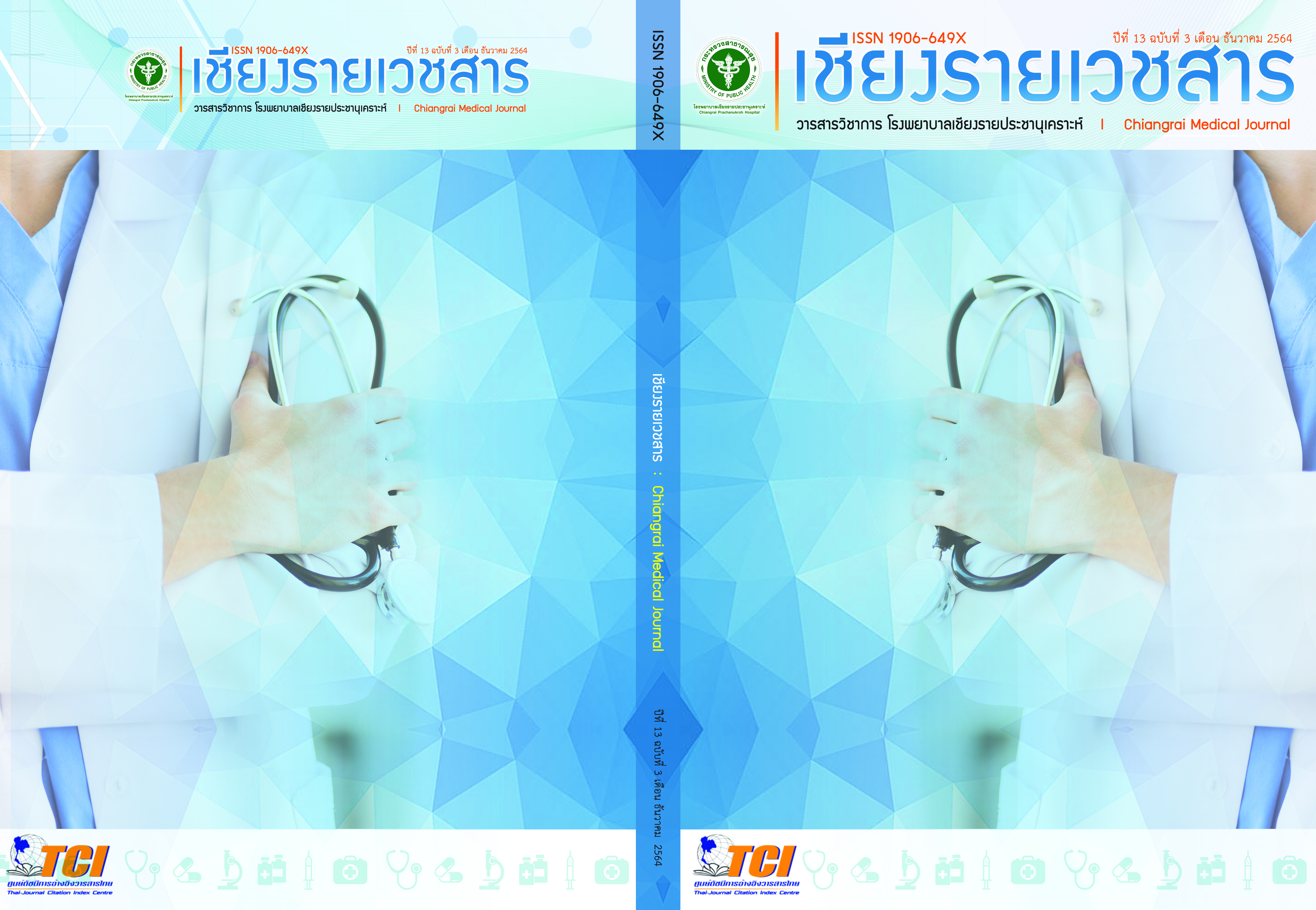กระดูกหักแบบละเอียด หรือกระดูกข้อมือผิดแนวมาทางด้านหน้า เพิ่มโอกาสเสี่ยงของกระดูกเคลื่อนมากขึ้นภายหลังการรักษาด้วยการดามลวดแบบปิดในผู้ป่วยกระดูกปลายเรเดียสหัก
Main Article Content
บทคัดย่อ
ความเป็นมา การรักษากระดูกปลายเรเดียสหักโดยการผ่าตัดดามลวดแบบปิด (Closed reduction with Percutaneous Pinning) เป็นวิธีการผ่าตัดที่ได้รับการยอมรับเนื่องจากทำได้รวดเร็วและลดภาระค่าใช้จ่ายของโรงพยาบาล แต่มีความแข็งแรงน้อยและมีโอกาสกระดูกเคลื่อนเพิ่มขึ้นในช่วงติดตามการรักษา
วัตถุประสงค์ เพื่อศึกษาอุบัติการณ์และปัจจัยที่ส่งผลให้กระดูกเคลื่อนมากขึ้นหลังการผ่าตัดดามลวดแบบปิดในผู้ป่วยกระดูกปลายเรเดียสหัก
วิธีการศึกษา ผู้วิจัยเก็บข้อมูลผู้ป่วยกระดูกปลายเรเดียสหัก ได้รับการผ่าตัดดามลวด ที่โรงพยาบาลเชียงรายประชานุเคราะห์ ในปี พ.ศ. 2561-2563 โดยประเมินข้อมูลจากเวชระเบียนและเปรียบเทียบภาพถ่ายทางรังสีก่อนผ่าตัด หลังผ่าตัด และ4-8 สัปดาห์หลังผ่าตัด แบ่งกลุ่มผู้ป่วยหลังผ่าตัดเป็นกลุ่มที่มีกระดูกเคลื่อนและกระดูกไม่เคลื่อนในขณะสิ้นสุดการรักษา และคำนวณหาปัจจัยเสี่ยงเพิ่มโอกาสการเกิดกระดูกเคลื่อนโดยวิธีการทางสถิติ
ผลการศึกษา ผู้ป่วยกระดูกข้อมือหักที่รักษาโดยการดามลวดแบบปิด 380 ราย หลังจากผ่าตัดดามลวดมีกระดูกเคลื่อน 89 คน คิดเป็นอุบัติการณ์ร้อยละ 23.42 ปัจจัยที่มีผลต่อการเคลื่อนของกระดูกเพิ่มขึ้นหลังผ่าตัดดามลวดได้แก่ กระดูกหักละเอียด (Comminuted fracture) ภาวะกระดูกข้อมือผิดแนวมาทางด้านหน้า (Volar carpal malalignment) เมื่อเปรียบเทียบปริมาณลวดที่ใช้ในการผ่าตัด พบว่าการใช้ลวด 3 ตัว เป็นปัจจัยป้องกันการเกิดกระดูกเคลื่อนหลังผ่าตัดเมื่อเปรียบเทียบกับใช้ลวด 2 ตัว
สรุปและข้อเสนอแนะ ในผู้ป่วยที่มีกระดูกปลายเรเดียสหักที่มีกระดูกหักละเอียด หรือภาวะกระดูกข้อมือผิดแนว การรักษาโดยผ่าตัดดามลวดแล้วมีโอกาสเสี่ยงเคลื่อนมากขึ้น แนะนำให้การรักษาเป็นการจัดกระดูกแบบเปิดแผลและใส่โลหะยึดตรึงภายในข้อมือ (Open reduction and internal fixation with plate and screws) ที่ให้ความแข็งแรงสูงกว่า หากเลือกใช้ลวดในการรักษากระดูกปลายเรเดียสหัก การใช้ลวด 3 ตัวอาจป้องกันการเคลื่อนเพิ่มขึ้นหลังผ่าตัดได้
Article Details
เอกสารอ้างอิง
Perugia D, Guzzini M, Civitenga C, Guidi M, Dominedò C, Fontana D, et al. Is it really necessary to restore radial anatomic parameters after distal radius fractures? Injury. 2014;45 Suppl 6:S21-6.
Karantana A, Handoll HH, Sabouni A. Percutaneous pinning for treating distal radial fractures in adults. Cochrane Database Syst Rev. 2020;2(2):CD006080.
Rosati M, Bertagnini S, Digrandi G, Sala C. Percutaneous pinning for fractures of the distal radius. Acta Orthop Belg. 2006;72(2):138-46.
Barton T, Chambers C, Lane E, Bannister G. Do Kirschner wires maintain reduction of displaced Colles' fractures?. Injury. 2005;36(12):1431-4.
Liao Q, Skipper NC, Brown MJ, Jenkins PJ. Percutaneous pinning versus volar locking plate fixation for dorsally displaced distal radius fractures- reoperation rates over an eight year period. J Orthop. 2018;15(2):471-4.
Stewart HD, Innes AR, Burke FD. Factors affecting the outcome of Colles' fracture: an anatomical and functional study. Injury. 1985;16(5):289-95.
Wolfe SW. Distal Radius Fractures. In: Wolfe SW, Pederson W, Hotchkiss R, Kozin S, Cohen M, editors. Green’s operative hand surgery. 7th ed. Philadelphia:Elsevier;2017. p.516-87.
Ng CY, McQueen MM. What are the radiological predictors of functional outcome following fractures of the distal radius? J Bone Joint Surg Br. 2011;93(2):145-50.
Selles CA, Ras L, Walenkamp MMJ, Maas M, Goslings JC, Schep NWL. Carpal Alignment: a new method for assessment. J Wrist Surg. 2019;8(2):112-7.
Court-Brown CM, Heckman JD, McQueen MM, Ricci WM, Tornetta P, III, McKee MD. Rockwood and Green's fractures in adults. 8th ed. Philadelphia: Wolters Kluwer Health; 2015.
Chaudhry H, Kleinlugtenbelt YV, Mundi R, Ristevski B, Goslings JC, Bhandari M. Are volar locking plates superior to percutaneous K-wires for distal radius fractures? A meta-analysis. Clin Orthop Relat Res. 2015;473(9):3017-27.
Vannabouathong. Vannabouathong C, Hussain N, Guerra-Farfan E, Bhandari M. Interventions for Distal Radius Fractures: a network meta-analysis of randomized trials. J Am Acad Orthop Surg. 2019;27(13):
e596-e605.
Youlden DJ, Sundaraj K, Smithers C. Volar locking plating versus percutaneous Kirschner wires for distal radius fractures in an adult population: a meta-analysis. ANZ J Surg. 2019; 89(7-8):821-6.
Kurup HV, Mandalia V, Singh B, Shaju KA, Mehta RL, Beaumont AR. Variables affecting stability of distal radial fractures fixed with K wires: a radiological study. Eur J Orthop Surg Traumatol. 2005;15(2):135-9.
Batra S, Debnath U, Kanvinde R. Can carpal malalignment predict early and late instability in nonoperatively managed distal radius fractures? Int Orthop. 2008;32(5):685-91.
Naidu SH, Capo JT, Moulton M, Ciccone W, II, Radin A. Percutaneous pinning of distal radius fractures: a biomechanical study. J Hand Surg Am. 1997;22(2):252-7.
Kurup HV, Mandalia V, Shaju A, Beaumont A. Bicortical K-wires for distal radius fracture fixation: how many?. Acta Orthop Belg. 2007;73(1):26-30.
Hosseinzadeh D, Janmohammadi N, Esmaeilnejad-Ganji SM, Frydoni MB. Comparison of radiographic results between three crossed pinning and four-pin radioulnar transfixation methods in the treatment of unstable distal radius fracture. J Evol Med Dent Sci. 2019;8(33):2597-602.
Clancey GJ. Percutaneous Kirschner-wire fixation of Colles fractures. A prospective study of thirty cases. J Bone Joint Surg Am. 1984;66(7):1008-14.
Levin LS, Rozell JC, Pulos N. Distal radius fractures in the ederly. J Am Acad Orthop Surg. 2017;25(3):179-87.
DeGeorge BR Jr, Van Houten HK, Mwangi R, Sangaralingham LR, Larson AN, Kakar S. Outcomes and complications in the management of distal radial fractures in the elderly. J Bone Joint Surg Am. 2020;102(1):37-44.
Weil NL, El Moumni M, Rubinstein SM, Krijnen P, Termaat MF, Schipper IB. Routine follow-up radiographs for distal radius fractures are seldom clinically substantiated. Arch Orthop Trauma Surg. 2017;137(9):1187-91.
Medoff RJ. Essential radiographic evaluation for distal radius fractures. Hand Clin. 2005;21(3):279-88.
Plant CE, Parsons NR, Costa ML. Do radiological and functional outcomes correlate for fractures of the distal radius?. Bone Joint J. 2017;99-B(3):376-82.


